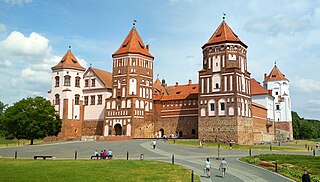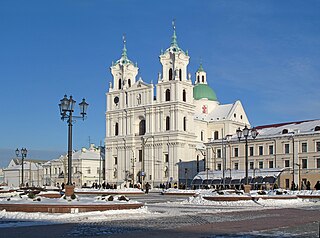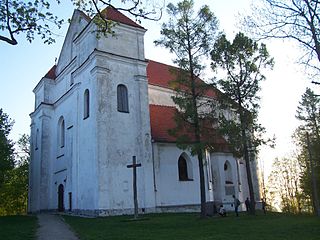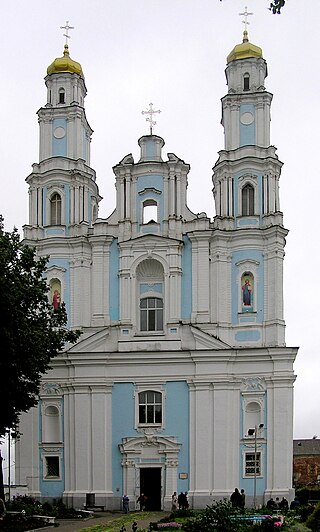
Grodno or Hrodna is a city in western Belarus. It is one of the oldest cities of Belarus. The city is located on the Neman River, 300 kilometres (190 mi) from Minsk, about 15 kilometres (9.3 mi) from the border with Poland, and 30 kilometres (19 mi) from the border with Lithuania. Grodno serves as the administrative center of Grodno Region and Grodno District, though it is administratively separated from the district. As of 2024, the city has a population of 361,115 inhabitants.

Grodno region, also known as Grodno oblast or Hrodna voblasts, is one of the regions of Belarus. Its administrative center, Grodno, is the largest city in the region. As of 2024, it has a population of 992,556.

The Bridgettines, or Birgittines, formally known as the Order of the Most Holy Saviour, is a monastic religious order of the Catholic Church founded by Saint Birgitta in 1344 and approved by Pope Urban V in 1370. They follow the Rule of Saint Augustine. There are today several different branches of Bridgettines.

The Abbey Pax Mariae, more commonly referred to as Vadstena Abbey, is situated on Lake Vättern in the Roman Catholic Diocese of Stockholm and is a monastery of nuns within the Bridgettine Order. It was active from 1346 until 1595 and has been active since 1963, regaining status as an autonomous abbey in 1991.

Zhyrovichy Monastery is an Orthodox monastery in Belarus, in the village of Zhyrovichy.
The Order of the Annunciation of the Blessed Virgin Mary, also known as Sisters of the Annunciation or Annonciades, is an enclosed religious order of contemplative nuns founded in honor of the Annunciation in 1501 at Bourges by Joan de Valois, also known as Joan of France, daughter of King Louis XI of France, and wife of Louis, the Duke of Orléans, later King Louis XII of France.

The Church of St. Michael is an Eastern Orthodox church on the northern outskirts of the village of Synkavichy, Zelva District, Hrodna Province, in Belarus. It is an example of the Belarusian Gothic and one of the first fortified churches in the Grand Duchy of Lithuania along with the Church of the Nativity of the Blessed Virgin Mary in Muravanka.

Church of the Blessed Virgin Mary was a Roman Catholic parish church in the city of Grodno. It was founded by Vytautas, Grand Duke of Lithuania before 1389 during the Christianization of Lithuania. Because of its founder, it was commonly referred to as Vytautas' Church. Rebuilt as a Gothic church around 1494, it was one of Grodno's principal Catholic churches until the post-World War II Soviet occupation. It was used by the Russian Orthodox Church since 1804 for roughly a century after the Catholic church was confiscated by the Russian Tsar. It was given back to the Roman Catholic Church during the interwar and World War II, except during the Soviet occupation of 1940–1941. Neglected in the aftermath of World War II, it was finally demolished in 1961.

The Holy Spirit Cathedral or the Holy Ghost Cathedral is a cathedral in Minsk, Belarus. Consecrated in honour of the Holy Spirit, it the mother church of the Belarusian Orthodox Church. It was built between 1633 and 1642 as a part Bernardine monastery during the Polish–Lithuanian Commonwealth in a place of former male Orthodox monasteries. The site became Orthodox again in 1860. The cathedral is listed as a Belarusian Cultural heritage object and is considered one of the main landmarks in Minsk Upper city.

Church of Holy Trinity also known as St. Roch on the Golden Hill is a Roman Catholic church in Minsk. In the 1930s, the church was closed and the valuables removed by the Soviet authorities. Renovation of the church started in 1983.

St. Francis Xavier Cathedral is a Roman Catholic cathedral in Grodno, Belarus. Originally a Jesuit church, it became a cathedral in 1991, when the new diocese of Grodno was erected. Nowadays it is one of only four minor basilicas in Belarus.

The Transfiguration Roman Catholic Church in Novogrudok, Belarus, is a Baroque church erected in 1712–1723, replacing an earlier Gothic building from the late 14th century, and originally consecrated under the title of Corpus Christi. Two Gothic chapels survive and are included in the Baroque building.

Aleksandra Marianna Wiesiołowska was the daughter of magnate Marek Sobieski and Jadwiga Snopkowska. She was married to Court Marshal of Lithuania Krzysztof Wiesiołowski and became later a Bridgettines as a widow.

The Church of the Assumption of the Blessed Virgin Mary is a former Bernardine, now parish Catholic Church in Budslaw, Myadzyel District, Minsk Region, Belarus. The church is a monument of architecture of the late Baroque, and enshrines the icon of Our Lady of Budslau widely venerated in the country.

Maria Gażycz, née Maria Nowina-Chrzanowska was a Belarusian-born Polish figure painter, art restorer, and nun in the order of the Sisters of the Holy Family of Nazareth.

Juliana Olshanskaya was a member of the Olshanski noble family who became a saint in the Eastern Orthodox Church. Dying a virgin around 16 years of age, she was buried in the monastery of Kyiv Pechersk Lavra. Decades later, her body was uncovered during the digging of a new grave. It is claimed that her remains were in a state of incorruptibility; relics were taken and she was venerated as a saint. The early 17th-century Archimandrite Peter Mogila claimed to have had a vision of Saint Juliana in which she reproached him for a lack of respect given to her relics. He arranged for nuns to create a new reliquary. The relics survived a fire in 1718 and are now in the church of the Near Caves. Her feast day is 28 September.

The Church of Saint Mary in Myadzyel, Belarus, is a Catholic church, listed as a Cultural Heritage object. The church was constructed in 1754 for the Discalced Carmelites' monastery.

The Monastery Saint Claire, also known as the Convent of Mary's Fear and by other names, is a convent of the Poor Clares on Tremor Hill in southern Nazareth, Israel. Established in 1884, it is primarily known for the productive time the now-sainted Charles de Foucauld spent there at the end of the 19th century. Expelled from the Ottoman Empire at the onset of World War I, the nuns of the abbey relocated to Malta, founding a new community there. The Sisters of St Clare returned to Nazareth in 1949 but used newer facilities on 3105 Street on the north slope of Tremor Hill. Their former location beside what is now Paulus HaShishi Street was repaired by the Servants of Charity for use as a special needs school in the 1970s.

The Cathedral of the Nativity of the Virgin is an Orthodox cathedral in the city of Hlybokaye, Vitebsk Region, Belarus. It is located in the historical center of the town on the 17th of September Square. It is the first monument and the most complete expression of the Vilnian Baroque school in Belarus, reflecting "important stages in the development of the artistic principles of the Belarusian Baroque". According to the researcher V. A. Chanturia, this cathedral is a rather peculiar type of religious architecture, because even in Europe temples with four towers of the Baroque period were very rare. Before the reconstruction in the 1730s, it was the only Sarmatian Baroque monument with a transept.

























